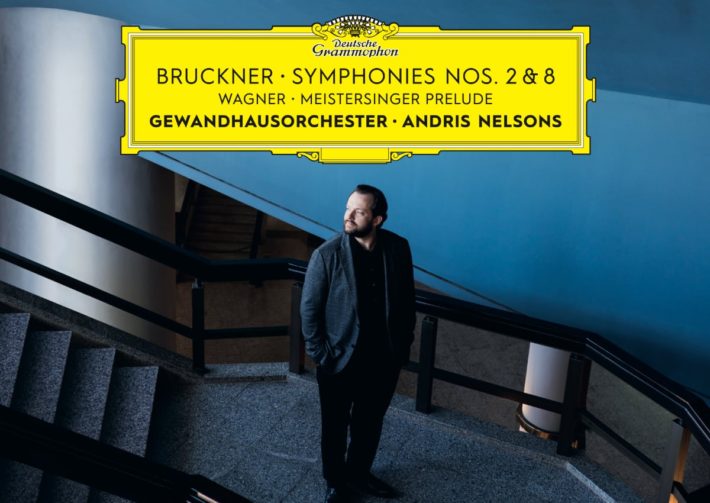Nelson’s Bruckner cycle enters the home stretch, with only the first and fifth symphonies left to complete the series. All but one of previous releases has also included works by Wagner and this new album opens with an impressive account of the Meistersinger Prelude. The Gewandhaus Orchestra sounds glorious and DG’s production is first-rate in every way. Nelsons concern for orchestral balance is apparent straightaway, the brass weighty without dominating the orchestral tutti.
The opening minutes have an infectious energy, but when the secondary material arrives (4’25”) Nelsons relaxes the tempo to wallow in the beauty of the orchestral sound, resulting in a significant loss of tension and momentum. At 6’00” Nelsons injects a shot of adrenalin into the music, the unusually sprightly tempo and individual articulation revealing a genuinely playful side to this music. The tuba solo (7’34”) has delightful character, while the final climax is powerful without the teutonic weight brought to this music by Karajan (Berlin) and Tennstedt (London).
Listeners interested in Bruckner’s second symphony are faced with multiple versions: the first version was completed in 1872, but the composer produced a revised version in 1877. The first critical edition (Robert Haas) conflates portions of both scores and is considered spurious by most scholars. One can find recordings of the Haas, as well as the two critical editions by Leopold Nowak, as well as the more recent editions by William Carragan – it is his edition of the 1887 version that is heard here.
I compared this new performance with two other recordings using the same edition, conducted by Barenboim (Berlin) and Janowski. Each performance offers excellent playing, but Nelsons reading seems more fully convincing. His tempos, both for entire movements, as well as the various sections within each movement, have an organic, integrated flow. The Gewandhaus orchestra plays with finesse and tonal sophistication that surpasses the Orchestre de la Suisse Romande (Janowski) and proves to be more than a match for Barenboim’s Berliners.
Janowski’s tempos often feel too fast, impressively athletic, but lacking in grandeur. His reading of the Adagio (14’21”) barely allows Bruckner’s sensuous chromatic harmonies to cast their spell. Nelsons takes about two minutes longer, but that extra time, wedded to careful attention to dynamics and supple phrasing, produces many moments of spiritual transcendence. Barenboim’s reading is the slowest of the three, and he encourages a weightier, sustained legato that seems better suited to the sound world of the final three symphonies.
Related Classical Music Reviews
- Review: Beethoven – Complete Symphonies – Vienna Philharmonic Orchestra – Nelsons
- Review: Bruckner – Symphony No. 8 – Vienna Philharmonic, Thielemann
- Review: Franz Schmidt – Complete Symphonies – Frankfurt Radio Symphony Orchestra, Paavo Järvi
Strangely, Nelsons’ tempo choices in the eighth symphony are less convincing. Karajan once stated that the key to a successful performance of this symphony was ensuring every tempo in each section related to one basic pulse, and indeed, that is one of the qualities that makes his last reading with the Vienna Philharmonic so remarkable. While Nelsons does achieve this in the first and third movements, his tempo for the Scherzo feels a bit fast. The Ländler character is replaced by youthful exuberance, or perhaps Nelsons is just reveling in how well his players can play the music at this tempo. Similarly, the opening of the final movement is simply a blur – even the gifted Gewandhaus trumpets cannot articulate their triplet figures clearly. At a slower tempo, both Karajan and Guilini (also Vienna) instill a slightly sinister quality to the relentless driving figure.
Perhaps Nelsons sees this music differently. Sample the opening minute of the first movement: the tremolo radiates warmth as the lower strings reach towards something positive. Then listen to Karajan’s realization of the same music – there is an extra frisson, a darker atmosphere as the cellos and basses crawl their way out of the darkness. Likewise, at the climax of the same movement (14’15”) the orchestra has the right weight and power, but the color is too bright, the unison trumpets (14’49”) too polite. Bruckner called this moment “Todesverkündigung” (Announcement of Death), and with Karajan and Guilini, that trumpet figure sends a shiver down one’s spine. Throughout the performance, Nelsons seems to downplay, to partially minimize, the struggle towards victory that is an integral part of this symphony’s emotional arch.
Nelsons’ viewpoint is certainly intriguing, and the orchestra executes his ideas with brilliance and incredible beauty. The third movement is simply stunning. And this is certainly a more thought-provoking interpretation than Thielemann’s most recent Vienna recording, reviewed here.
Karajan’s final recording of the eighth remains my primary recommendation because it captures the emotional arch of the work more fully than any other performance I know. But this new recording has a great deal to offer, and with its exceptional performance of Bruckner’s second symphony, is warmly recommended.

Bruckner – Symphonies No.2, WAB 102, Symphony No. 8, WAB 108
Wagner – Die Meistersinger Von Nürnberg: Prelude to Act I
Gewandhausorchester Leipzig
Andris Nelsons
Recommended Comparisons
Read more classical music reviews or visit The Classic Review Amazon store
Follow Us and Comment:
Get our periodic classical music newsletter with our recent reviews, news and beginners guides.
We respect your privacy.









